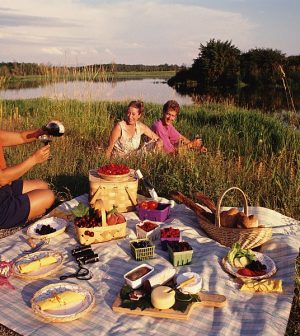- Skip Storing This Everyday Product in the Fridge Door
- Green Tea + B3 Pairing May Boost Brain Health
- Navigating Your Midlife Crisis: Embracing New Possibilities
- City Raccoons Showing Signs of Domestication
- Mapping the Exposome: Science Broadens Focus to Environmental Disease Triggers
- One Week Less on Social Media Linked to Better Mental Health
- Your Brain Changes in Stages as You Age, Study Finds
- Some Suicide Victims Show No Typical Warning Signs, Study Finds
- ByHeart Formula Faces Lawsuits After Babies Sickened With Botulism
- Switch to Vegan Diet Could Cut Your Greenhouse Gas Emissions in Half
Put Safety First When Planning to Pack Food-to-Go

Whether you’re tailgating, cooking for a potluck or bringing in a treat for co-workers, keep safety in mind to avoid food-borne illnesses.
Safe handling is always important, but it’s an even bigger priority when you’re away from your kitchen, without the benefit of your fridge and oven to control food temperatures. The key is to plan ahead to keep food safe until eaten. The golden rule is to keep cold foods cold — below 40 degrees, and keep hot foods hot — above 140 degrees.
Keeping cold food cold means you’ll need to use a cooler with cold packs or lots of ice, and keep it in the shade. Foods that don’t need to be stored in the cooler include whole fresh fruits and vegetables, nuts, and peanut butter and jelly.
If you’ll be cooking, such as grilling, at the venue, carry raw food in its own cooler, double wrapped in plastic to contain any juices. Bring disposable wipes for hand washing. If you’re taking food to a friend’s home for a BBQ, for instance, keep meat and poultry refrigerated until ready to put on the grill. Since food may brown before it’s cooked through, test with an instant-read thermometer for safety.
Best Internal Temperature for Cooked Meats
- Red meat: 145 degrees
- All ground meat: 160 degrees
- Poultry: 165 degrees
If cooking in batches, place cooked meats off to the side of the grill rack or in a 200-degree oven until serving. And, of course, never use the same platter and utensils for raw and cooked meat and poultry.
One final note: Any leftover food is safe to take home only if it was kept in a cooler, and the cooler still had ice in it.
More information
The U.S. Department of Agriculture has more tips on food safety when you’re cooking on-the-go.
Source: HealthDay
Copyright © 2025 HealthDay. All rights reserved.










